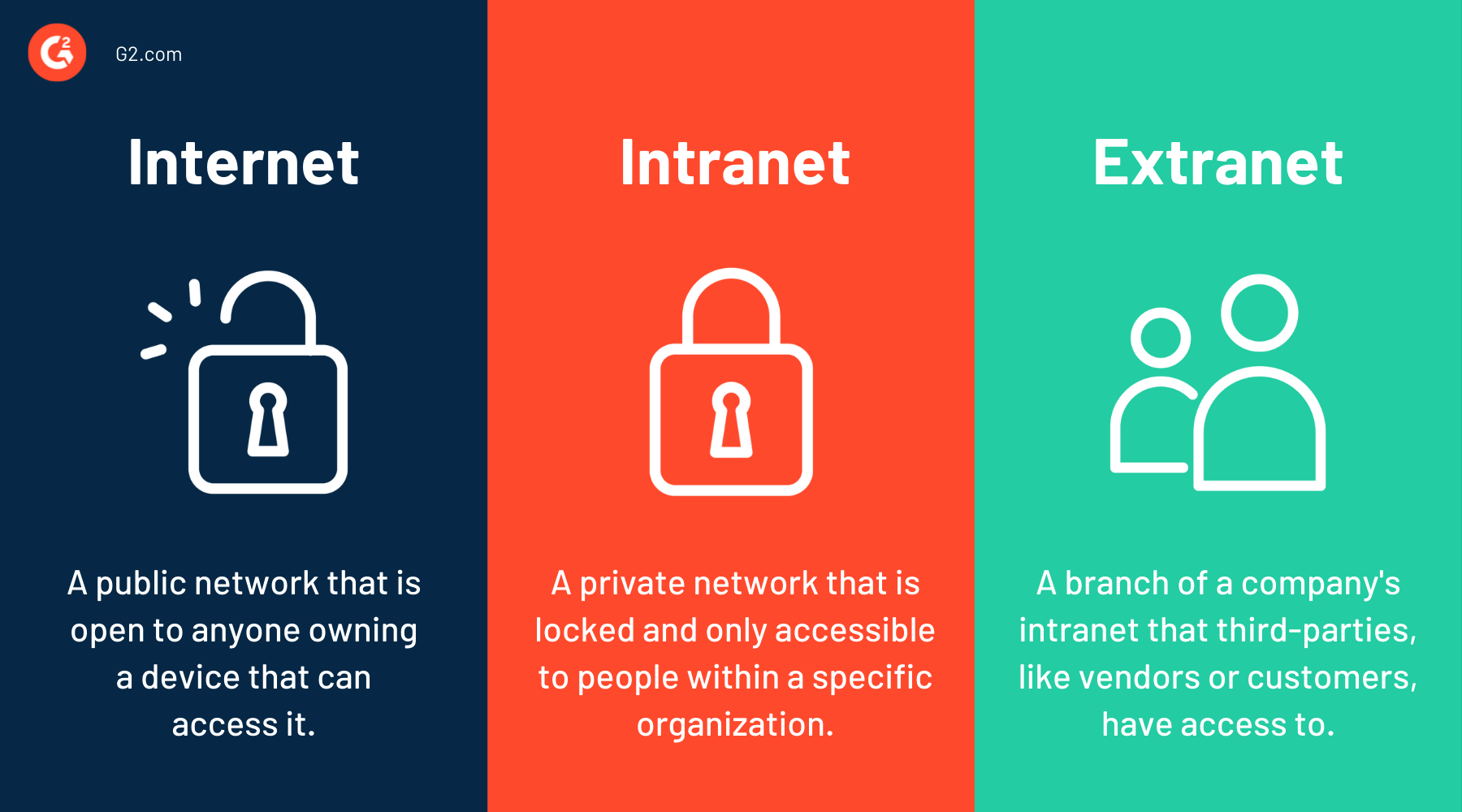Business and technology grow at similar paces.
This is primarily because of how well they complement each other. As new technologies develop, businesses incorporate them into their stack. Similarly, as companies progress, they create their own technology to meet their unique needs.
With so many options for tools and software to use, you’d think using business technology would be simple. Unfortunately, that’s not the case.
Over time, businesses’ inventory of resources gets out of control, making accessing information a nightmare. Throughout the workday, you probably find yourself asking questions about the information you need. Where do I find this information? Who do I ask about it? Where do I share what I’ve found?
Wouldn’t it be nice if there was a single place that enabled communication and stored the resources you need to do your job successfully? That magical place exists, and it is called an intranet.
Intranet definition:
An intranet is a private online network that is only accessible to members within an organization. Its main purpose is to provide employees with the information, resources, and collaboration tools they need to work toward their goals.
You don’t need to be a huge corporation to benefit from employee intranet software. These platforms can serve any team, in any business, within any industry.
How does an intranet work?
First and foremost, an intranet needs a secure and reliable web server to manage requests for data hosted on the server. The web server works to find requested files and delivers them to the user who needs them. It’s also essential to have a content management system set up to control how content on the intranet is managed.
When an employee wants to access their company’s intranet, they’ll need to be connected to the company’s local area network (LAN) and have a specific network password . If the company has remote employees, those individuals access the intranet through a virtual private network (VPN). A VPN makes it possible for those not connected to the LAN to sign in to the intranet and access the same information and resources.
A firewall is also in use to keep an organization's intranet secure. It works by standing between the outside internet and the private intranet to track all incoming and outgoing data, confirming they don’t contain any unauthorized requests. Firewalls also protect an intranet by making sure malware or other malicious threats don’t hack into the network.
Finally, an intranet basically looks like a private version of the internet due to the element of tunneling, which makes it possible for companies to send private messages through the network. To do this, intranets utilize encryption and decryption to safeguard one part of the intranet from another.
Top 5 employee intranet software options:
* These are five leading employee intranet tools from G2’s Fall 2021 Grid® Report.
¿Quieres aprender más sobre Software de Intranet para Empleados? Explora los productos de Intranet de empleados.
What is the purpose of intranet?
You’re probably wondering what an intranet can do for your business. But the better question is: what can’t an intranet do for your business?
An intranet acts as the backbone of internal communication. The business world moves quickly, and establishing an intranet as your business’ single source for information, communication, and collaboration boosts productivity. Once your team nails productivity, success will follow.
Some popular uses of an intranet are:
- Storing and organizing files securely
- Time tracking and logging time worked on specific projects
- Collaborating with teams across borders or in different offices
- Connecting employees with one another
- Booking appointments and meetings with other employees
- Sharing organizational updates and enhancing internal communication
- Boosting productivity throughout the organization
Difference between internet, intranet, and extranet
It’s common to confuse an intranet for simply being the internet or an extranet. Intranets became popular in the 1990s, the same time as the internet, so it’s understandable why people may find themselves confused – especially when you consider you need the internet for an intranet to work.
These three tools are similar, so it's important to distinguish how they differ from one another.

The internet is open to everyone who owns a device that can access it, like a computer or mobile device with a Wi-Fi connection. The internet is a free-for-all, per se, since it’s a public and globally-connected network.
An intranet is an online source of information used by businesses. Intranets are locked and only accessible to people within a specific organization. It’s a privately owned, local, or restricted network and not available for anyone trying to get online.
An extranet is similar to an intranet, but certain people outside the organization can also access it. It’s essentially a branch of a company’s intranet, given to third parties like vendors, partners, suppliers, or customers.
Intranet features and benefits
If you’re thinking about incorporating an intranet into your business’s internal communication plan, you’re on your way to productivity. Before implementing, there are some features you might want to make sure are included for you and your company to reap all the possible intranet benefits.
Document management
Managing and sharing documents is one of the most important features of an intranet. Ensuring all team members have the knowledge base they need to add value to the business should be a priority.
Because business is anything but stagnant, knowledge bases are constantly changing. Policies, procedures, goals, and company personnel require regular updates, and communicating them to the entire business can be done using an intranet.
A proper intranet software organizes company documents and makes them easily accessible to members of the company. From email threads to documents in Google Drive, having a company intranet allows employees to store and access all of their files easily.
Internal knowledge is valuable, sensitive information. Intranets can not only act as a central repository for company data, but they can also keep it secure from external audiences.
Benefit: Security. Sensitive information and data can be kept safe in a company intranet with the help of virtual private network (VPN) software.
Collaboration and communication tools
Teamwork is key in the workplace. Even if you’re tackling a project alone, there will be times when you need information, advice, or approval from others before moving forward.
Using various internal communication channels within one company can create clutter, causing employees to miss important pieces of information. A company intranet eliminates these problems.
Intranets include features for team members to easily collaborate throughout the entire duration of a project. These collaboration features make it easy to share information on the intranet, and are always available for whoever might need it.
Additionally, many intranets offer user profiles similar to LinkedIn so employees can upload their own profile and include their job title, description, and more. This also makes it possible to discover new colleagues and send them a message over the intranet, allowing for increased collaboration and helping to establish a network in the workplace.
Benefit: Better internal communication occurring across all levels. A company intranet allows communication to move from peer to peer, subordinate to superior, or vice versa.
Ability to create groups
Many departments exist within a business: human resources, accounting, marketing, and more. They all matter to the success of an organization, but they require different information to contribute to it.
An intranet allows groups to be created to further organize information according to the team’s function and responsibilities. Piling all the information from every team in one place can discourage people from using your company’s intranet, but organizing it is an excellent way to avoid this. But of course, there will be spaces with information relevant to all company members, no matter their department.
Creating groups on your company intranet is a must for project management. A shared space where those working on the same project can communicate, collaborate on tasks, and stay updated on progress helps simplify the process.
Benefit: Organization. Some resources are specific to certain teams, so creating groups based on team function can filter unnecessary information.
Search engine and simple user interface
Intranets store all of a company’s information in one place. While this is extremely convenient, it’s also a lot of information.
Thankfully, intranets offer search tools. Employees can enter a general keyword and browse results for the information they need or even search the exact name of the file they’re looking for.
A streamlined user interface (UI) will make your intranet much easier to use. A clear and organized interface with relevant drop-down menu items and action buttons make an intranet more functional and user-friendly for your employees.
Benefit: Boosts efficiency. With the help of search tools and simple UI design, intranet users can be in and out and back to work with the information they need in minutes.
Ability to customize
Every business is different, meaning your intranet should be unique to your company. The intranet software you choose should be flexible to meet the needs of your business. This might mean highlighting specific tools to make the site more user-friendly or simply adding employer branding to personalize it.
One of the more interesting and exciting features about intranet software is that if it lacks a feature you need, it can integrate other commonly used software to be accessed through your company intranet. Some modern intranets can integrate with external tools like Google Workspace, Microsoft 365, Slack, Okta, and Zendesk.
Benefit: Contributes to company culture. Whatever your company stands for should be at the forefront of your intranet software to remind employees of your business’ purpose and culture.
Disadvantages of an intranet
There are clearly many benefits for organizations that turn to using an intranet. However, companies should also be aware of the potential challenges, too.
- Challenging for deskless workers: Intranets can be extremely useful for companies with a traditional office. However, deskless workers may not have the ability to access an intranet, such as retail workers, warehouse staff, truck drivers, nurses, and even remote workers.
- Mobile isn’t always supported: Many intranets don’t support mobile devices from the start. Sometimes it’s common for intranets to offer mobile as an updated release or upgraded package for businesses to purchase. When looking for the best intranet for your organization, make sure to look for one with a mobile intranet app.
- Updates may be time-consuming: Communication technology is constantly improving, changing, and evolving. Because of this, we’ve become used to regularly scheduled updates and new releases. However, it can take years for an upgraded version of an intranet to be released to customers.
The total package
Using a company intranet helps relieve the stressors of internal communication. The right one can provide a home for all the information, resources, and collaboration tools employees need to be productive and contribute to company goals. Even if your business already runs like a well-oiled machine, a solid company intranet can only add more oil.
As businesses grow, they incorporate more and more software into their tech stack. These tools can pile up fast, and managing software can become a giant pain. See how G2 tack can effectively manage and optimize your SaaS spend.

Mary Clare Novak
Mary Clare Novak is a former Content Marketing Specialist at G2 based in Burlington, Vermont, where she is explored topics related to sales and customer relationship management. In her free time, you can find her doing a crossword puzzle, listening to cover bands, or eating fish tacos. (she/her/hers)

